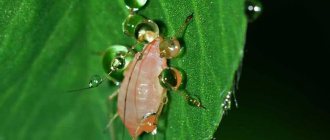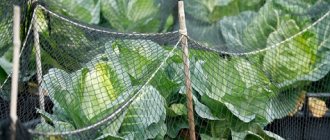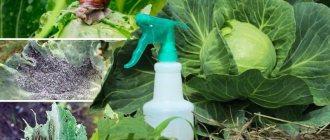Pest control agents and treatment times
A gardener has a large number of industrial preparations and folk remedies for controlling cabbage pests. It is important to notice signs of insect infestation in time and carry out treatments in such a way that folk remedies are effective and chemicals do not cause harm.
Folk remedies
For small lesions, pests can be controlled without the use of pesticides. Home remedies are cheap, safe for people and bees, and in some cases serve as a source of nutrients for cabbage.
Advantages of products prepared according to folk recipes: they can be used several times during any period of the cabbage growing season if pests are detected.
Recipes for infusions against harmful insects:
- 200 grams of dry crushed tobacco leaves are poured into 2 liters of boiling water, left for 2-3 hours. The strained solution is brought to a volume of 10 liters. For better adhesion to the leaves, add 50 grams of liquid soap to the infusion.
- 200 grams of tomatoes and 200 grams of garlic cloves are passed through a meat grinder. The resulting slurry is poured into 10 liters of water, the solution is filtered, and used for spraying.
- 500 grams of raw materials from dandelion roots and leaves are crushed in a blender, pour 10 liters of water and leave for 6-8 hours. The filtered solution is processed.
- To prepare the infusion, take 1 glass of ash and 200 grams of tobacco dust in a bucket of water, leave for a day, and filter.
- 100 grams of mustard powder are infused in 10 liters of water for 6-7 days. The filtered solution is sprayed.
- Wood ash is sifted, mixed with slaked lime or tobacco dust, young cabbage seedlings are dusted and sprinkled between rows.
Recipes for decoctions against pests:
- 1 kg of celery stalks is crushed, poured into 2.5 liters of water, boiled for 30 minutes, allowed to brew for 2-3 hours. The broth is filtered, diluted in a bucket of liquid with 50 grams of grated laundry soap.
- 2 kg of potato tops leaves per half bucket of liquid, boil for 15 minutes. The strained broth is diluted with water to a volume of 10 liters.
- 100 grams of hot pepper pods are crushed, simmered over low heat for 45-60 minutes, cooled, filtered. Bring the volume of liquid to 10 liters, add 40 grams of liquid soap.
Solutions of chemicals used in everyday life that are effective against cabbage pests:
- 1 tbsp. 9% table vinegar or 250 ml of apple cider vinegar are diluted in a bucket of water. Before you start spraying, the solution is tested on the outer cabbage leaf , if after 2-3 hours no burn is observed, treatment can be carried out.
- 10 ml of ammonia are diluted in a bucket of water. The solution is watered into the holes or sprayed over the leaves.
- Pour 0.5 liters of low-fat milk or whey into a bucket of water, add 10 drops. potassium iodide. The resulting solution is sprayed onto the plants.
Folk remedies act gradually, they have a cumulative effect.
Industrial products
Synthetic drugs should be used with caution, strictly observing the dosage and waiting time (the period from the last treatment to harvest). Benefits of insecticides:
- quickly cause the death of pests;
- effectively solve the problem at any degree of damage, suitable for emergency treatments;
- have a prolonged validity period.
To avoid the occurrence of resistance, insecticides should be alternated. The instructions for each drug indicate the active substance, the permissible frequency of treatments and the waiting time.
If used excessively, toxic chemicals accumulate in cabbage tissues and can harm human health.
Pesticides of contact and contact-intestinal action, entering the gastrointestinal tract of the insect, cause paralysis of the nervous system, the death of the pest occurs within a few hours.
| Active substance | Drug names | Frequency of treatments, waiting period |
| Deltamethrin | "Decis Profi" | 2 (20) |
| "Atom" | 2 (20) | |
| Organophosphorus compounds (malathion, pirimiphos-methyl) | "Fufanon-Nova" | 2 (30) |
| "Iskra-M" | 2 (20) | |
| "Aktellik" | 2 (30) | |
| Cypermethrin | "Inta-Vir" | 3 (30) |
| "Aliot" | 1 (20) | |
| Lambda-cyhalothrin | "Karate" | 1 (30) |
| "Sensei" | 2 (20) |
Systemic insecticides - “Commander”, “Aktara” are effective against a wide range of pests. The drugs accumulate in all parts of the plant and destroy insects at all stages of development.
Biological products are created on the basis of beneficial bacteria and fungal spores. They are less effective, but have a low (IV class) hazard, they can be used 5-7 days before harvest:
- “Bitoxibacillin;
- "Fitoverm";
- "Lepidocide."
Biological products are effective at air temperatures not lower than +18˚С.
Preventive measures: how to protect your garden from caterpillar invasion
Pest control will be much more difficult if preventive measures are not taken in time. Many problems can be avoided thanks to a few simple operations:
- after harvesting, thoroughly clean the garden and remove all remaining debris - tops, roots and other plant debris, take it away or burn it;
- dig the soil to a depth of at least 14 cm, use agrofibre;
- If there are areas with wild grass near your garden, treat them regularly - mow the grass, pull out flowering plants, etc. (Pay special attention to common wild plants of the cruciferous family (colc, shepherd's purse, etc.). They have common pests with cabbage, and must be destroyed first);
- feed the birds in winter to attract them to the garden;
- Think in advance about protective plantings of spicy and fragrant plants.
The appearance of caterpillars in cabbage beds is a nuisance, the elimination of which can take a lot of effort and time, but the opportunity to get a rich harvest of delicious vegetables is worth it. Everyone can choose the best way to get rid of caterpillars, from expensive chemicals to simple improvised means.
Main pests and treatments
An experienced gardener is able to determine the type of pest that has appeared in the beds by the appearance of cabbage, assess the degree of damage, and choose the optimal control measures.
Aphid
Small greenish-gray insects feed on cabbage juice; colonies of pests multiply quickly and become more active in hot, dry weather. Affected leaves acquire a pinkish tint and curl. The process of photosynthesis in the plant is disrupted, it loses the ability to absorb nutrients, and heads of cabbage do not set. Aphids are carriers of viral and fungal infections.
What to process. In case of minor damage, cabbage is sprayed with infusions of ash, potato and tomato tops, and tobacco dust. In severe cases, insecticides “Fufanon-Nova”, “Iskra-M”, “Decis Profi”, “Fas” are used, which are diluted according to the instructions.
Thrips
Small insects invisible to the naked eye. They first appear on weeds, then move on to cabbage. The female pest lays eggs, and after a few days the larvae appear. During a season, 7-8 generations of parasitic insects may appear.
Rusty spots appear between the cabbage leaves, and black dots of insect excrement are clearly visible. Pest colonies become more active in hot, dry weather.
What to process. Spraying with infusions of potato or tomato tops, garlic, mustard or hot pepper helps get rid of uninvited guests. In case of mass damage, the drugs “Fufanon-Nova”, “Iskra-M”, “Karate Zeon” are used.
Cruciferous flea beetle
Small bugs measuring 2-3 mm are one of the most harmful pests of cabbage. Black individuals with yellowish stripes on the elytra are distinguished by their jumping ability. The massive appearance of the parasite on young plantings can lead to the death of a significant part of the crop.
Flea beetles eat the above-ground part, gnaw through the thin stem of seedlings, and beetle larvae gnaw at the roots of the crop. The flea does not like moisture, so abundant watering helps improve the situation.
What to process. Effective against the pest are dusting plants with ash and tobacco dust or slaked lime, spraying tobacco infusion, tomato shoots and potato tops, dandelion, and vinegar solution. The following drugs are used: “Aktara”, “Aliot”, “Fufanon-Nova”.
Cabbage scoop
An inconspicuous gray butterfly that is nocturnal. The flight of overwintered insects occurs at the end of May. Butterflies lay eggs on the inside of leaves. After 10-12 days, green or brown caterpillars appear and begin to actively eat the above-ground part of the plant.
They gnaw the stems of young seedlings, and make holes in the leaves of grown vegetables, sometimes leaving only veins of the leaf plate.
How to treat : use insecticides “Iskra-M”, “Inta-Vir”, “Aktellik”, biological products - “Bitoxibacillin”, “Lepidocid”, “Fitoverm”.
Folk remedies: a decoction of hot pepper or wormwood, an infusion of wood ash with tobacco dust. Before spraying, add 40 grams of liquid soap per 10 liters of liquid to the solutions. Timely weeding and loosening of row spacing helps reduce the number of pests.
Cruciferous bug
Red or black insects with a contrasting geometric pattern on the back. The greatest damage is caused by the beetle larva, which pierces the leaf with its proboscis and sucks out the juice. At the site of damage, light spots appear and tissues die, and the cabbage leaf gradually dries out.
What to process. Strong-smelling agents are used against the pest: infusions of valerian, garlic, nightshade, solutions of vinegar and ammonia are used. For severe lesions, pesticides are effective: “Karate Zeon”, “Atom”, “Decis Pro”.
Cabbage and turnip whites
The butterfly has white wings framed by a black border, with two large black spots. 2-3 days after departure, it lays up to 200 bright yellow eggs on the bottom of the cabbage leaf. After 8-10 days, light green or speckled caterpillars appear, which can reach a size of 5 cm.
Leaf-gnawing pests eat the edges of cabbage leaves and make large holes in the leaf blades. In case of large lesions, a skeleton of veins remains from the plant.
What to process. Butterflies are repelled by strong odors - the plants are sprayed with an infusion of garlic, tomatoes, and wormwood. Dusting the leaves with ash helps - the butterfly does not lay eggs on contaminated surfaces.
Insecticides are used against caterpillars: “Decis”, “Karate Zeon”, “Iskra-M”. Early varieties of cabbage are sprayed with biological agents with a short waiting period - “Bitoxibacillin”, “Lepidocide”.
Cabbage fly
There are two known types of pests: spring and summer. The mass emergence of the spring cabbage fly, a gray insect with transparent wings up to 6.5 mm in size, occurs during the flowering of lilacs. This coincides with the timing of planting cabbage seedlings in open ground.
One individual is capable of laying up to 100 eggs. Flies make clutches on the stems of seedlings, the root collar, and in the soil. White larvae appear after 5-8 days and begin to actively gnaw into the stem and root system of the plant. The roots die and the seedlings wither even with sufficient watering.
In mid-late June, the summer variety of the insect emerges. The hatched larvae gnaw winding passages in the stems and leaves of cabbage, which acquire a blue-leaden hue.
What to process. To repel the pest, the soil between the rows is sprinkled with ash and mustard or hot pepper, and watered with a solution of ammonia. If there are a large number of larvae, plants are sprayed with pesticides: “Aktellik”, “Fufanon-Nova”, “Karate-Zeon”, watered at the roots with “Aktara”, “Commander”. Early varieties are treated with biological products - “Fitoverm”, “Lepidotsid”.
Mole cricket and May beetle larva
Pests live underground and gnaw at the roots of young seedlings and adult plants, leading to their death. The mole cricket is a large insect, 3-5 cm in size, brown-brown in color with a hard shell. The larvae of the May beetle are thick, white, 3-3.5 cm in size.
Parasites enter beds from fresh manure or compost heaps and are activated when the soil becomes waterlogged. The presence of pests can be suspected if there is a sudden sudden death of plants for no reason. The mole cricket leaves small holes and earthen paths near the cabbage bushes.
What to process. To repel pests, the beds are spilled with infusion of garlic, ammonia or mustard. The following drugs help destroy parasitic insects: “Aktara”, “Bazudin”, “Medvetox”, “Zemlin”. The holes are watered with pesticides, and granular forms are placed under the plants.
Slugs
Voracious mollusks cause a lot of trouble for gardeners in rainy weather. On sunny days, slugs hide in the lower leaves of the cabbage. Pests actively eat leaves; their saliva contains an enzyme that leads to darkening of leaf plates and the development of rot. Shellfish serve as carriers of viral and fungal pathogens.
What to process. Plants affected by slugs are sprayed with a vinegar solution, infusion of mustard or hot pepper. They set traps - sugar syrup or beer is poured into small containers, then the drowned pests are collected. Pesticides are used: “Metaldehyde”, “Slug eater”. Granules of the preparations are laid out under bushes and between rows.
Cabbage butterfly: description
The Cabbage White is a small powdery white butterfly with the tops of the front pair of wings edged with black down to the middle of the wing. Females have two black spots on their front wings in the form of small round spots; in males, such spots are located on the underside of the wings. When an insect lands on cabbage, it becomes difficult to notice it; the fact is that the lower part of the wings is yellow-green or grayish-yellow in color.
One female can lay up to 250 eggs per season. The underside of plant foliage serves as a place for laying eggs. The eggs of the insect are yellow, the caterpillars first have a light green color, then, in the process of development, after several molts, they become yellow-gray. Before wintering, the caterpillars move to trees or other places higher from the ground, wrap themselves in silk thread and freeze until April. In the spring, a butterfly will emerge from the pupa.
The butterflies themselves do not harm the plants; they feed on the nectar of flowers, but the insect caterpillars happily feed on cruciferous plants; cabbage suffers the most from the voracious pest. First, the larvae eat the edges of the leaves, then the larvae and caterpillars, if you do not get rid of them in time, can destroy an entire head of cabbage.
Final table
| Pest | Means |
| Aphid | “Iskra-M”, “Fufanon-Nova”, “Decis-Profi”. Infusion of ash and tobacco dust, tomato or potato tops |
| Thrips | "Iskra-M", "Karate-Zeon", "Fufanon-Nova". Infusions of tomato tops and potato tops, garlic, mustard, hot pepper decoction |
| Cruciferous flea beetle | “Fufanon-Nova”, “Aktara”, “Aliot”. Spraying with infusion of dandelion, tobacco, potato tops, a solution of vinegar or ammonia. Dusting with ash with tobacco or slaked lime. |
| Cabbage scoop | “Inta-Vir”, “Iskra-M”, “Bitoxibacillin”, “Fitoverm”, “Lepidotsid”. A decoction of hot pepper, an infusion of wood ash and tobacco. |
| Cruciferous bug | “Karate-Zeon”, “Decis-Profi”, “Atom”. Infusions of garlic, valerian, tomato stepsons. Solutions of ammonia or apple cider vinegar |
| Cabbage white, turnip white | “Iskra-M”, “Decis-Profi”, “Karate-Zeon”. Biological products - “Lepidocid”, “Bitoxibacillin”. Infusions of garlic, potato tops, dusting the plant with ash. |
| Cabbage fly | “Fufanon-Nova”, “Aktellik”, “Karate-Zeon”, “Lepidotsid”, “Fitoverm”, “Commander”. Ammonia solution, ash, hot pepper, mustard |
| Medvedka | "Aktara", "Medvetox". Sprinkling between rows with hot pepper, tobacco, mustard |
| May beetle larva | “Bazudin”, “Aktara”, “Zemlin”. Watering the soil with ammonia, garlic infusion |
| Slugs | "Metaldehyde", "Slug Eater". Spraying with infusion of mustard, hot pepper, vinegar solution. Sprinkling row spacing with pine needles and eggshells. |
What plants repel the cabbage butterfly?
- Cabbage whites do not like peppermint, tomatoes, or celery. Among the flowers she does not like are nasturtium, marigolds, marigolds, and borage (borage). This is why mixed plantings of vegetables are so popular in natural farming - different smells confuse the insect, and the butterfly rarely chooses such places to lay eggs. It’s a good idea to plant celery in the cabbage, and place tomatoes nearby, interspersed with marigolds or calendula.
- Cabbage caterpillars do not like hyssop, dill, garlic, onions, tansy, and wormwood. So plant such neighbors near the cabbage to protect it from the invasion of cabbage butterflies.
Despite the pretty appearance of daytime white butterflies, they actually cause considerable harm, so it is better to immediately protect yourself from the pest, not to give the cabbage grass the opportunity to settle in the beds, and for this it is advisable to use long-known and proven folk methods. We are sure that information about which plants repel the cabbage butterfly will be useful, and you, too, will begin to use combined plantings in the garden.
Subscribe to article announcements and stay with us, and you will learn about the safest ways to protect plants - we will continue the topic of pests and plant diseases.
Interesting life hacks
Popular thought is not asleep, and such research is supported by famous farmers of the country.
The famous garden designer and TV presenter Olga Platonova advises sticking sticks with washed egg shells on the tops next to the cabbage. Flying over these devices, the cabbage butterfly will think that another of its fellow tribesmen is laying eggs in this area, and will not touch the planting.
What means do you use to combat cabbage?
ChemicalFolk
Reputable gardeners also advise covering slightly grown cabbage with low-density white non-woven material or a mesh with small cells. Then not only the whitefish, but also other pests will not be able to penetrate here. In the same way, you can save cabbage from other pests.
Some lay out boards between the rows of plantings, and when caterpillars crawl under them in the heat, they collect and destroy the pests.
Expert opinion
Mityuk Stefania Bogdanovna
Gardeners also plant next to plants that are annoyed by whites, onions, garlic, and marigolds. The smell of these crops will repel pests, and you will receive additional decorations in the form of flowers, and you will be able to compact the plantings by growing onions and garlic here.
Mechanical methods of control
One cabbage butterfly is capable of breeding 2-3 generations of caterpillars per season. With the onset of warm spring days, you can already see white moths flying. At the beginning of summer, caterpillars hatch from the laid eggs, which then grow into butterflies. They will give rise to another generation of pests.
The caterpillars that pupate at the end of summer - beginning of autumn overwinter in the cracks of buildings and houses. They may also be located under the bark. To prevent pests from overwintering here, farmers whiten trees at the end of autumn. At the same time you need to inspect the bark. If you notice cabbage butterfly pupae here, you need to remove and destroy them.
The next mechanical method is used at the beginning of summer. It is necessary to periodically inspect the underside of the leaves, and if a clutch of eggs or caterpillars is found, they are destroyed.
Expert opinion
Mityuk Stefania Bogdanovna
I try not to use “chemicals” in my garden. Previously, I offered children such entertainment - catching cabbage butterflies with nets. And the kids are happy about this activity, and most of the pests were neutralized using this mechanical method.
Growing cabbage
Why doesn't cabbage set a head?
Cabbage first stores a supply of nutrients in the covering leaves, like a storeroom, to be used when laying the head of cabbage. Typically, the head of cabbage begins to set when there are 7–9 covering leaves. Many people take them off for some reason, that is, they empty the pantry, and the cabbage stubbornly begins to grow them again.
In addition, cabbage may simply be under-eaten and under-drink. Start giving increased feeding (at least 2 liters per week), and everything will go great. The reason may also be dry soil in hot weather. Increase watering. Another common reason is insufficient lighting. Cabbage is very light-loving and will not set a head in the shade.
The cabbage wilted, watering did not help. I pulled the plant out of the soil, and it had rot on the roots. Why?
The root system of cabbage rots when there is a large amount of nitrogen in the soil (for example, due to the addition of fresh manure), and when soil moisture is above 90%.











